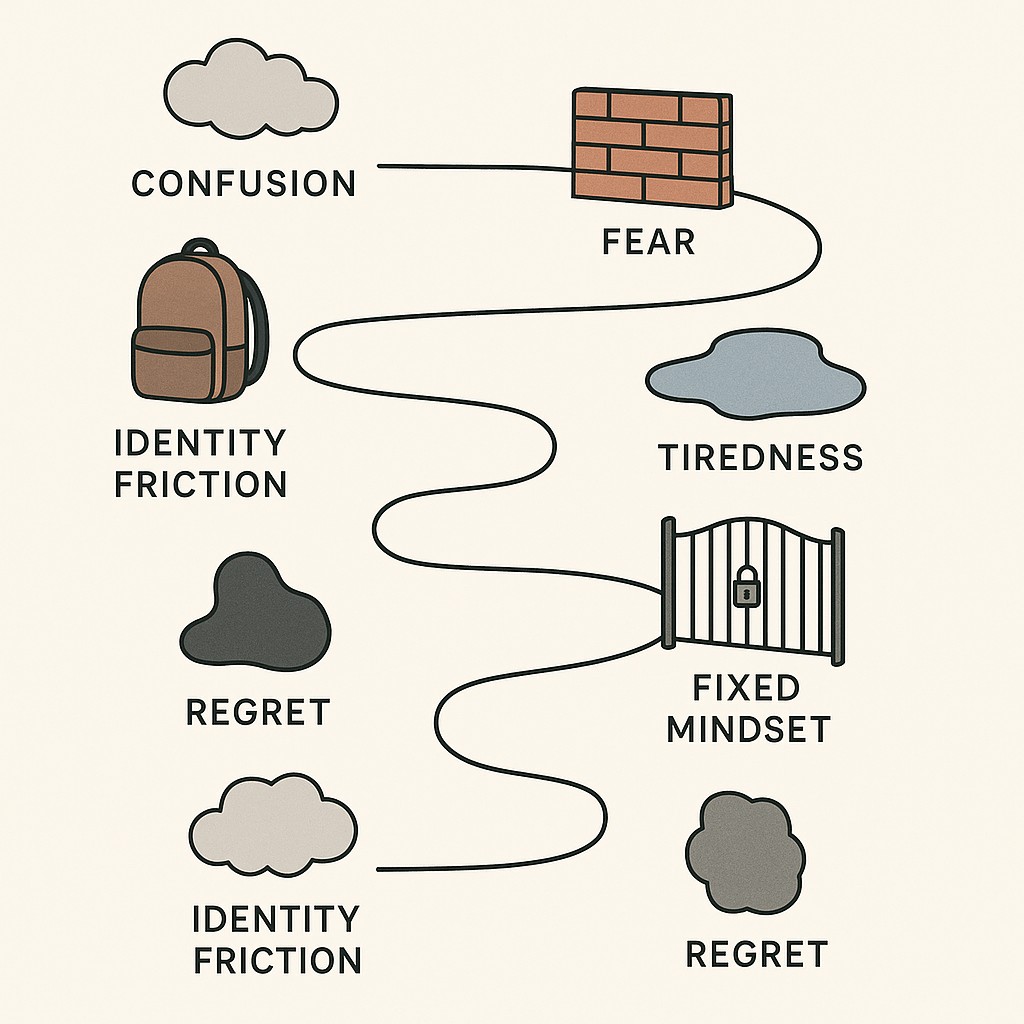Get Unstuck on Complex Tasks: A 7-Day Blocker Map
Get Unstuck on Complex Tasks: A 7-Day Blocker Map

From “Lazy” to Clear Blockers: Get Unstuck on Complex Tasks With the 7‑Day Momentum Shift
A week ago I landed on César’s post charting out seven flavors of laziness in engineers, and it stopped me cold. Not just because of the list itself—confusion, fear, regret, and more—but the actual framing. It was spotlighting blockers instead of blaming personalities. That shift felt huge. Instead of wrestling with “Am I just lazy?” the focus became: What’s actually stopping me today? Suddenly, this didn’t feel personal. It felt practical. It got me wondering what would change if we all swapped out the label for the real underlying cause and did something about it.
When you try to Get unstuck on complex tasks, you’ve probably stared down something ambiguous, risky, maybe even a bit high-stakes—and hit that wall where nothing budges. It’s so common to call yourself lazy in those moments, but honestly, that label misses the mark. Most of the time, you’re not lazy—you’re blocked. And here’s what’s really happening: People who struggle with procrastination often have trouble regulating their emotions and fall into mind-wandering traps that hijack their attention—blocked, not lazy.
So what if, instead of beating yourself up, you just diagnosed the blocker, picked a tiny move that chips away at it, did it, and then logged a one-sentence win? Momentum builds. You break the pattern. In seven days, you’re shipping, not stalling.
Here’s the promise. I’ll walk you through the map to Get unstuck on complex tasks by spotting the real blocker and stacking micro-actions until progress feels automatic. Let’s get you unstuck.
Map the Blocker, Not Yourself
Let’s cut through the fog. You’ll see lazy tossed around all over, but if you want to actually get moving, identify procrastination blockers and swap that label for one of these seven: confusion, fear, fixed mindset, tiredness, lack of interest, regret, and identity friction. Picture it like debugging—not “Why is my code bad?” but “What’s jamming up the works?” When you name the real error, the fix shows up way faster. You’re not broken or unmotivated. Your energy just gets caught in a jam and needs a clear path out.

Before you even try tackling the work, scan for the bottleneck. Notice where your attention spikes or your stomach drops when you think about the task. Is it messy instructions, worry about being judged, not caring about the result, or something else? Feel for that moment right before avoidance kicks in—what would you circle if you could only choose one blocker?
If you’re worried about getting it wrong, honestly so is everyone else. The blocker isn’t always obvious, especially at first. Treat this whole thing like an experiment. You guess, you take a shot, and you nudge it again tomorrow. Odds are, something will shift, even if only a little. You’re iteration, not diagnosis perfection. No badge here, just forward movement.
People often doubt small moves. I get it. When you’re stuck, everything feels big or useless. But think of momentum as friction reduction, not goal posts. Micro actions for momentum mean less resistance tomorrow. Do it again, and the path keeps clearing. When you chip away at friction with tiny steps, progress snowballs. The reason this compounds is that momentum isn’t willpower. It’s a series of easier starting points. That’s why the 7-day challenge works. It’s not training grit, it’s tilting the table, so action gets simpler each round.
Don’t just trust the process blindly, log your win. Start a journal. Write one sentence about what you accomplished today to remind yourself you’re proactive. Progress itself nudges us to take on tougher challenges and stick with them longer, which is why tracking those micro-wins matters more than any pep talk.
Some days, you’ll find two or three blockers tangled up. That’s normal. Just pick one to reduce first. Momentum likes a single target.
I still fall for the old “I’m just not the type who follows through” narrative sometimes. It’s not really true—I just forget to break things down small enough. Still happens.
The 7‑Day Cure for Laziness Challenge
Here’s the move. For seven days, you target a new blocker each day and knock it down with one micro-action. This isn’t about big overhauls. It’s seeing what’s stuck and picking something small—really small—that points directly at it. A targeted action is the tiniest possible intervention. To beat analysis paralysis, don’t try to figure out the whole roadmap—you just clarify one step, or pick the next button. Now, laziness isn’t the problem. Blockers are, and you can cut them down one at a time.
Let’s get concrete. On Day 1, let’s say you’re facing confusion. Your micro-action might be as basic as “define what success looks like for this task,” or writing down what’s unclear. For fear, spend ten minutes mapping out the worst actual consequence, then do a reset ritual like a short walk, to signal that the stakes aren’t infinite after all. Whatever you do, it should fit in a single, uninterrupted ten-minute window. You’re not aiming for finish lines, just friction reduction.
For lack of interest, flip the script—make it a game. Set a timer on your phone for eight minutes and challenge yourself to “beat the clock” by working until the buzzer. You’re giving the task just enough tension to feel new, instead of dragging it out like a penalty. It’s less about the output and more about sparking momentum. You’ll be surprised how fast a tiny reward can jumpstart effort.
Here’s where it gets personal. Sometimes tiredness isn’t just physical—it’s everything-heavy, especially when your sense of self clashes with the work. I’ve avoided some tasks for days, stewing in friction, until I renamed them in a way that matched who I want to be. When a task feels hard, your brain will either treat that as proof it matters (which sparks persistence) or as proof you’ll fail and should walk away—identity-based motivation in action. The trick is finding a label or angle where you feel like the kind of person who does this, even if it’s just “someone who finishes ten minutes.”
A couple years ago, I tried what I thought would be a clever approach: kept a running list of micro-actions on sticky notes around my monitor. Sounded foolproof. But half of them fell off and got lost behind the desk, and I was mostly just annoyed at the scraps under my keyboard. Sometimes even a “good” system is just another block. What finally got me moving was picking one thing and writing it at the top of a blank page, nothing else. It felt barebones but it stuck—maybe because there was nowhere for the task to hide.
Here’s the daily loop. Each morning (or whenever the resistance buzz hits), pick the blocker you’re facing, choose one micro-action that chips away at it, execute, then log a one-sentence win. Done. That’s it. Come back tomorrow and hit the next block. Seven days, seven clears, new forward momentum, one concrete result each time.
Real-World Moves for Everyday Blocks
If you’re staring at a spec that reads like soup, here’s your move. Treat confusion as the real blocker, not your ability. Write down three questions you need answered to move forward—no need to be clever, just honest. Send those questions to whoever’s closest to the source. Then log the win: “Asked three concrete questions.” The relief kicks in fast, and the work gets way less mysterious. I’ve seen it firsthand—framing cuts down the back-and-forth. Turns out, getting specific early makes momentum almost automatic.
Overcome tech procrastination when refactoring mess is stressing you out. Don’t go big. Take fifteen minutes, pick one part of the code, and create a single high-signal test or snapshot. Focus just on that module, ignore the rest. You’ve already started. Progress isn’t overhaul, it’s pinpointed action.
Got that post-experiment hangover—the regret after another ML run you’re sure was wasted? Write one honest sentence about what actually went sideways. Don’t dress it up, don’t bury it in a doc, just get it out. Then take a ten-minute walk. Put the project down, clear out the sunk-cost fog. When you’re back, the “this was pointless” loop has loosened, and you’re not carrying yesterday’s mistakes straight into the next round.
Sometimes “laziness” is really identity friction—especially when you’re leading. Next time you hit that wall with an update that feels meaningless, rename it: call it a “design note,” not a “status update.” Jot two bullet points. Log the win. The label shift does something subtle; you prove to yourself that laziness isn’t permanent—it’s just a block you can overcome. The feeling really does change.
About the “I don’t have time for micro-actions” objection. Most engineers over-engineer the fix when stuck, trying to brute force a breakthrough in one marathon session. I’ve been there—spending hours on side docs, diagrams, research, getting nowhere. Here’s what changed.
I broke down the problem into ten-minute micro-actions. After that, I started seeing real movement, even though each step felt trivial. Do the math—a week of micro-moves adds up to more actual progress and less wasted effort than a single all-in session that never finishes. It’s not about shrinking your ambition. It’s about stacking momentum until the task isn’t so heavy. When you see what a dozen micro-wins can do, you’ll stop caring that they’re small. Forward motion is what ships things.
Compound Momentum: Share Your Blocker and Your Win
Start today. Pick one blocker—doesn’t matter which—and choose a micro-action that directly targets it. Do it before you close your laptop. Then log a one-sentence win and what’s been blocking you, either in your notes or a team chat, to overcome procrastination at work. Sharing your blocker and your win isn’t just for you; it helps normalize focused progress and clears room for others to step up.
Need a fast micro‑action to share progress? Use our app to generate AI‑powered drafts, tailored to your goals, constraints, and tone, so updates, docs, and posts ship with less friction.
If you guess the blocker wrong, no stress. You’ll re-run the loop tomorrow, and every pass stacks new momentum. That’s how progress builds, not all at once but piece by piece, each micro-action chipping away at the wall.
Remember back near the top when I said this didn’t feel personal anymore? That shift is the whole point. This is how you reclaim agency—one small move, one friction cut, one logged win at a time. Confidence grows with every round, and the work that actually matters starts shipping. Just keep reducing the right friction and let the momentum carry you forward.
Enjoyed this post? For more insights on engineering leadership, mindful productivity, and navigating the modern workday, follow me on LinkedIn to stay inspired and join the conversation.
You can also view and comment on the original post here .
